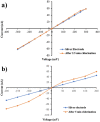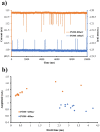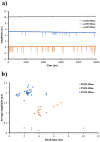Large-scale production of polyimide micropore-based flow cells for detecting nano-sized particles in fluids
- PMID: 36686911
- PMCID: PMC9811244
- DOI: 10.1039/d2ra07423k
Large-scale production of polyimide micropore-based flow cells for detecting nano-sized particles in fluids
Abstract
In diagnostic and sequencing applications, solid-state nanopores hold significant promise as a single-molecule sensing platform. The fabrication of precisely sized pores has traditionally been challenging, laborious, expensive, and inefficient, which has limited its applications until recently. To overcome this problem, this paper proposes a novel, reliable, cost-effective, portable, mass-productive, robust, and ease-of-use micropore flow cell that works based on the resistive pulse sensor (RPS) technique in order to distinguish the different sizes of c nanoparticles. RPS is a robust and informative technique that can provide valuable details of the size, shape, charge, and individual particle concentrations in the media. By femtosecond laser drilling of a polyimide substrate as an alternate material, translocation of 100, 300, and 350 nm polystyrene nanoparticles in PBS buffer was distinguished by 0.1, 1, and 2 nA current blockade levels, respectively. This is the first time a micropore has been opened in a polyimide membrane using a femtosecond laser in a single step. The experimental and theoretical investigation, scanning electron microscopy and focused ion beam spectroscopy were performed to comprehensively explain the micropore's performance. We showed that our innovative micropore-based flow cell could distinguish nano-sized particles in fluids, and it can be used in large-scale production because of its simplicity and cost-effectiveness.
This journal is © The Royal Society of Chemistry.
Conflict of interest statement
There are no conflicts of interest to declare.
Figures








References
-
- Dogan Guzel F. Avci H. Fabrication of Nanopores in an Ultra-Thin PI Membrane for Biomolecule Sensing. IEEE Sens. J. 2018;18:2641–2646.
-
- Li J. Stein D. McMullan C. Branton D. Aziz M. J. Golovchenko J. A. Ion-beam sculpting at nanometre length scales. Nature. 2001;412:166–169. - PubMed
-
- Yusko E. C. Bruhn B. R. Eggenberger O. M. et al., Real-time shape approximation and fingerprinting of single proteins using a nanopore. Nat. Nanotechnol. 2016;12:360–367. - PubMed
-
- Briggs K. Kwok H. Tabard-Cossa V. Automated Fabrication of 2-nm Solid-State Nanopores for Nucleic Acid Analysis. Small. 2014;10:2077–2086. - PubMed
LinkOut - more resources
Full Text Sources

